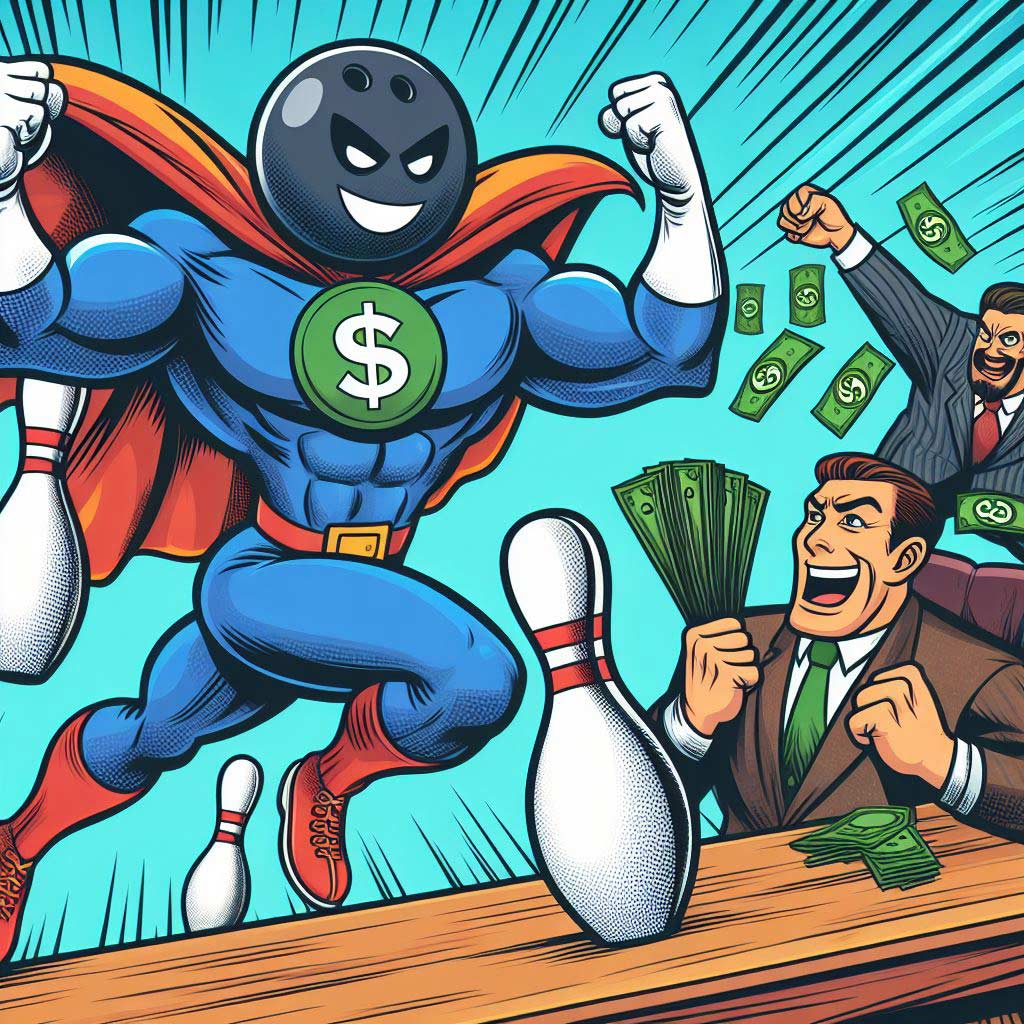Have you ever been caught off guard by the bowling alley charges after a fun night out rolling strikes? You start with reasonable expectations – maybe $5 or $10 a game. But after a few hours, you end up with a bill over $100!
What gives? Well, bowling pricing can be complex, with hourly lane rentals, shoe rentals, game charges, peak pricing, and much more factoring in.
As costs add up from games, food, drinks, and more, your budget can end up in the gutter if you don’t know bowling alley pricing frameworks.
That’s exactly what I want to shed light on in this complete cost breakdown. By understanding the key variables around hourly bowling pricing, you can set accurate budget expectations and decide if hitting the lanes makes sense for your entertainment dollar. Let’s break it down!
How Bowling Alley Pricing Works
First, it helps to understand how most public bowling alleys price out lane time. Back in the day, you simply paid per game you bowled rather than renting a lane per hour. But today, most modern bowling centers operate on a time-based rental fee for lanes.
This means bowlers reserve a lane at an hourly rate, much like other entertainment venues. Typical rates fall between $20-$40 per lane, per hour from what I’ve seen.
So if you have 4 bowlers, you’d divide that hourly lane rate to determine cost per person – more on that later.
These hourly lane rental rates can swing up or down based on a few key factors:
Peak vs. Non-Peak Hours
Like other retailers, bowling alleys tweak pricing based on demand trends. Peak times with lots of bowler traffic – Friday nights, Saturday afternoons, etc – come at premium pricing. The same lane may drop $10/hour on a Tuesday morning.
Aim for non-peak times like weekday mornings to grab lane specials as low as $15/hour if you want max savings!
Weekend vs. Weekday Pricing
For obvious reasons, weekends tend to hit peak pricing more often than weekdays. Center owners need to capture revenue when consumer entertainment spending peaks on Fridays and Saturdays. So you’ll almost always pay more per hour on weekends.
That said, weekday afternoon specials are common when business is slower. Keep your eyes open for promotional emails or social media posts from local centers advertising discounted hourly rates to drive business when school and work are in session.
Ultimately, expect your typical bowling lane rental to run $25-35/hour on weekends and drop closer to $20 on weekdays during normal business hours.
Okay, so hourly lane rental rates make up the bulk of bowling alley charges. But what other costs come into play?
Extra Costs and Fees to Be Aware Of
Beyond lane time rental, several supplemental fees factor into the total tab when budgeting for bowling:
Rental Shoes – $5 Per Person
Bringing your bowling shoes will save you cash. But most casual bowlers opt for rentals, usually around $5 per person. Some places even charge per game. Grab your shoes quickly to avoid ticking fees!
Game Charges
If you still pay per game rather than renting an entire lane for group play, costs run $4-$8 per game depending on location. When budgeting the group outing, game charges stack up quickly!
Food, Drinks and More
Where bowling alleys often drive revenue are concessions, arcade games, billiards, and more that accompany lane play. Soda, beer, nachos, hot dogs…it adds up!
Try to come with a full belly or limit extras for cost control. But know that you’ll likely spend at least a few dollars more per person beyond lane rental and shoe fees.
Tips for Saving Money Bowling
If you don’t need state-of-the-art scoring technology, shiny decor, and upscale food, check your area for old-school bowling alleys charging just a few bucks per game. No frills but easy on your wallet!
Joining a league locks in discounted rates as league bowlers commit to regular weekly play. Some groups play for small cash pots per night rather than trophies at season’s end. It’s budget competition!
Of course, avoiding Friday and Saturday prime time slots keeps hourly rates lower if weekends work for your schedule.
Bowling just 1-2 hours saves big versus a full 4-hour block, even when considering lane rental divides across your group. Speaking of groups…
The Per Person’s Breakdown
Let’s take a look at potential per-person costs for bowling to set expectations across group sizes and durations. Assuming weekday, non-peak pricing, costs generally shake out like this:
Parties of 2
- 2 hours of bowling
- $20 lane rate per hour ($40 total)
- $5 shoe rental per person ($10 total)
That’s $25 per person for 2 hours of entertainment. Very reasonable! This makes bowling an affordable option for double dates, parent/child outings, and more with just two participants.
Parties of 4
- 2 hours bowling
- $30 lane rate per hour ($60 total)
- $5 shoe rental per person ($20 total)
- Split 4 ways = $20 per person
With 4 people, costs remain relatively low per individual. This covers casual friend groups, double date duos teaming up, family outings, and keeping things budget-friendly.
Parties of 6
- 3 hours bowling
- $35 lane rate per hour ($105 total)
- $5 shoe rental per person ($30 total)
- Split 6 ways = $22 per person
Larger parties of 6 driving 3 full hours of play does require a cost expectation of around $25+ per bowler once shoes, lane time splits and any incidentals add up. Still, pretty good bang for your buck!
When considering 8 people or more per lane, costs remain comparable to the 6-person pricing above. Centers won’t force groups above 6 per lane, but not all fees are split down further either. Ultimately, stick below 8 bowlers per lane to control individual budget impact.
The Most Affordable Bowling Options
After understanding the standard bowling pricing models above, where can you bowl for less? Check out these budget-friendly options:
-
Kids Bowl Free Deals
Programs like Kids Bowl Free offer 2 free games daily all summer long at participating bowling alleys nationwide.
Children must be accompanied by a paying adult, but the free kids’ play makes this an awesome budget option for families looking to bowl without breaking the bank!
-
Old School Bowling Alleys
In small towns and cities across America, you can still find vintage 1950s-style lanes with manual pinsetters, wood lanes instead of synthetic materials, and cash payment instead of debit cards.
No massive arcade rooms or lounge areas – just affordable bowling by the game! Expect to pay $3 or less per round.
-
Join a League
Committing to a full season in a bowling league drives per night or game rates down considerably through bulk play.
Plus you get social time with other league members and potential prize money! League bowlers pay between $10-$20 each week for a few games + shoes which saves big over walk-in rack rates.
The Takeaway
When asking “How much is bowling per hour?”, you now have the full scoop on lane rental fees plus supplemental costs that contribute to total spending.
While $40 per hour per lane sounds expensive, splitting between 4-6 bowlers keeps things relatively affordable as group entertainment.
To maximize savings, opt for off-peak weekday specials, limit extra food/drink splurges, and perhaps find an old-school alley charging by the game only.
The most budget-friendly plan is bowling just 1-2 hours as a small group of 2-4 close friends or family members.
With this detailed breakdown, you can now choose when to indulge in a few games or when keeping funds in your wallet makes the most sense. See you at the lanes! Need help to lace up those rental shoes?
Frequently Asked Questions
Is bowling an expensive sport?
Bowling does not have to be an expensive sport. While bowling alley lane fees, equipment costs, and league fees can add up for frequent bowlers, occasional recreational bowling can be very affordable entertainment with hourly lane rates starting as low as $15 per lane. Going during off-peak times, sharing lanes as a group, limiting food purchases, and using house balls and rental shoes help keep per-person costs down.
How long does it take to bowl 1 game?
One standard game of bowling takes between 10 and 15 minutes if playing at a typical pace. This allows enough time for each player to comfortably approach the lane and bowl their frames. Professional bowlers may complete games faster while amateur recreational bowlers tend to be on the lower end.
How many people can bowl in one lane?
Most bowling alleys allow up to 6 people max to share a single lane. Larger groups would need to split across two neighboring lanes. Centers want to ensure bowlers have enough elbow room during approach and release without crowded throw spaces around each lane.
How do you properly bowl?
Proper bowling technique starts from the approach – controlled steps towards the foul line, swinging the ball straight back and forward pendulum-style finishing with a smooth release and follow through. Other basics include choosing the right ball weight for your body strength, getting the appropriate finger hole fit, and aiming for bowling lane targeting arrows rather than the pins themselves. Lessons can help ingrain proper basics.
Is bowling a sport or hobby?
Bowling is considered both a competitive sport at professional levels and a popular casual hobby for recreational participants. As a sport, bowling takes athletic precision requiring hand-eye coordination, balance, strength training, and cultivation of technique. As a hobby, bowling is simply fun group entertainment for parties young and old looking to bond and socialize around friendly competition. For any level of play though, bowling offers excitement when pins crash down for that satisfying strike!
Is bowling a cool sport?
Absolutely – bowling is undeniably a classic, cool American sport! The unique atmosphere combining dim mood lighting, glowing neon decor, slick bowling balls sending pins flying, strikes triggering rock music, tasty greasy food, and socializing old friends or new makes bowling alleys eternally hip places full of cool. Professional bowlers have enjoyed celebrity status and kids young and old alike appreciate bowling’s cool factor during parties.
How many games can you bowl in an hour?
Bowling at a brisk pace, most bowlers can finish 4 full games within a 1-hour session if not take extensive breaks between frames. At this rate, each game spans about 15 minutes including brief rests. More realistically during casual public bowling, groups tend to complete 2-3 games per hour. Highly skilled league players may bowl 5+ full games in an hour when bowling rapidly.
Is bowling good for a first date?
Bowling makes for an excellent, relaxed first-date activity! The sport’s casual nature invites conversation to get to know each other when not throwing balls. Bowling experiences frequent ups and downs lending themselves perfectly to breaking the ice through laughter. Winners can gloat playfully and comfort those gutter balling. And regardless of final scores, sharing tasty snacks after friendly competition sets a fun, positive first date tone.
How many games of bowling should you do?
For most casual bowlers not in a league, 1-3 hours max with 2-5 games bowled is ideal. Beyond that fatigue, decreasing scores, and boredom can set in if not an elite competitive player. It’s best to end the outing on a high note like after bowling your top game rather than dragging on too long. For kids and elder bowlers, even shorter sessions of just 1-2 games prevent burnout while still bringing plenty of excitement in knocking down pins!





